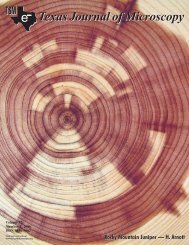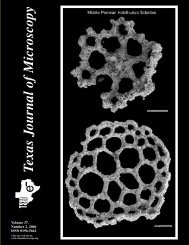Texas Journal of Microscopy - Texas Society for Microscopy
Texas Journal of Microscopy - Texas Society for Microscopy
Texas Journal of Microscopy - Texas Society for Microscopy
You also want an ePaper? Increase the reach of your titles
YUMPU automatically turns print PDFs into web optimized ePapers that Google loves.
Figure 2. Prince Valiant fights <strong>for</strong> his life and possibly King<br />
Solomon’s gold. Adapted from Hal Foster’s Prince Valiant by<br />
Gianni and Schultz, 2006.<br />
I am a long time devotee <strong>of</strong> the comic strip Prince Valiant.<br />
First thing Sunday morning I look <strong>for</strong> it in the paper. Other<br />
comic strips do not interest me, but somehow, when I was<br />
young “Prince Valiant” captured my imagination. All <strong>of</strong> the<br />
panels are extremely well done, in fact, each is like a piece <strong>of</strong><br />
fine art. The colors are rich and the characters are robust. The<br />
artist(s) utilize different size panels rather than the traditional<br />
four used in many comic strips. Sometimes they use only a single<br />
very large panel. These panel size changes add character<br />
to the strip. The drawings always exhibit a great feeling <strong>for</strong><br />
perspective and a fantastic sense <strong>of</strong> reality. The story line is<br />
continuous and moves slowly; one “episode” may take several<br />
weeks. Prince Valiant in the days <strong>of</strong> King Arthur, © King Features<br />
Syndicate, was originally written by Hal Foster (no relation<br />
to Adriance Foster) starting in 1937 and over the years was<br />
illustrated by a number <strong>of</strong> artists. It is now written and drawn<br />
by Gary Gianni and Mark Schultz as Hal Foster’s Prince Valiant.<br />
Some <strong>of</strong> you will say this paragraph is interesting but<br />
completely immaterial. However, there is a connection! On<br />
Sunday three weeks after starting Part IV, and tentatively deciding<br />
that I could relate “my crystal trail” to the events in the<br />
novel King Solomon’s Mines, I found Prince Valiant enmeshed<br />
in a fight <strong>for</strong> King Solomon’s Treasure (Fig. 2). Whether it was<br />
a fluke, a twist <strong>of</strong> fate, or coincidence I took it as a sign! It gave<br />
me confidence that I was on the right trail. In November and<br />
December <strong>of</strong> 2006 “the coin <strong>of</strong> Solomon” and King Solomon<br />
himself, returned to the plot <strong>of</strong> Prince Valiant.<br />
THE CRYSTAL TRAIL<br />
Crystals <strong>of</strong> CaOx in plants will be the first stop on the trail.<br />
From there the trail goes in diverse directions (Plates 2, 3). Perhaps<br />
the crystal trail is more like a web since it led to the study<br />
<strong>of</strong> algae, plants, fungi, vertebrates, plant and insect viruses and<br />
finally, believe it or not, to wood.<br />
The crystal research described<br />
here involves my own work and<br />
joint studies with students, seasoned<br />
investigators, a housewife<br />
and even a detective. In many<br />
ways the “webbiness” <strong>of</strong> this<br />
trail came from the influence<br />
<strong>of</strong> Dr. Frederick G. E. Pautard,<br />
the friendly Englishman (Fig 3).<br />
Soon after I met him in the middle<br />
60’s, we became both friends<br />
and research associates. Fred<br />
was trained in biophysics in the<br />
Astbury Lab at Leeds University.<br />
He was a persistent fisherman<br />
at home or abroad; a bon vivant,<br />
and an original “multitasker.” But<br />
above all he was always a “ruthless<br />
intellectual.” In many ways,<br />
the “webbiness” also derives<br />
Figure 3. F.G.E. Pautard in<br />
the snow at Davos, Switzerland,<br />
1965.<br />
from Gordon Whaley, who, I believe, moved in the background<br />
in many ways to expand my research life. As you will see later,<br />
Fred Pautard, Kenneth Smith and Colin Nicol were all “pawns” in<br />
Whaley’s pastime <strong>of</strong> local edification. I will recount these stories<br />
in a chronological manner, with occasional flashbacks, as in King<br />
Solomon’s Mines. The chief members <strong>of</strong> my crystal trail safari<br />
were: Adriance Foster (UC Berkeley); Fred Pautard, Kenneth<br />
Smith, Colin Nicol (UT Austin and U <strong>of</strong> South Florida); Mary<br />
Alice Webb (UT Arlington and Purdue U). There were others<br />
but these five “carried the load” just as the porters did <strong>for</strong> Quatermain.<br />
I will introduce each <strong>of</strong> them as we go along the trail.<br />
To embark on “The Crystal Trail,” first I want to recall an<br />
incident in the life <strong>of</strong> Adriance S. Foster. In 955 he gave the<br />
retiring president’s address at the annual banquet <strong>of</strong> the American<br />
Botanical <strong>Society</strong> held at Michigan State University. His address<br />
was entitled, “Plant Idioblasts: Remarkable Examples <strong>of</strong><br />
Cell Specialization” (Foster, 956). A note at the beginning <strong>of</strong><br />
the published version <strong>of</strong> his address says, “Dr. Foster’s address<br />
was illustrated with a series <strong>of</strong> excellent slides <strong>of</strong> mixed botanical<br />
and psycho-entomological nature.” His address included pictures<br />
<strong>of</strong> sclereids and crystal idioblasts much like those we studied in<br />
his plant anatomy class but he also showed cartoons <strong>of</strong> grasshoppers<br />
with sclereids stuck in their “teeth” hence the editor’s comment.<br />
In 968, well along on my crystal trail, I had the pleasure<br />
<strong>of</strong> addressing the American Botanical <strong>Society</strong> in a symposium on<br />
plant idioblasts. My lecture ended with a photograph <strong>of</strong> Adriance<br />
S. Foster, and naming him the “greatest idioblast <strong>of</strong> all.” See<br />
Part III <strong>for</strong> pictures <strong>of</strong> Foster.<br />
While Foster’s course in plant anatomy was near the beginning<br />
<strong>of</strong> my crystal trail, the actual start was a study <strong>of</strong> longitudinal sections<br />
<strong>of</strong> yucca roots, wherein I found that raphide crystal idioblasts<br />
arise in files (Fig. ). In my dissertation I wrote: “Large numbers<br />
<strong>of</strong> raphide-containing idioblastic cells occur in the cortex <strong>of</strong> the<br />
roots <strong>of</strong> many Yucca species, especially Y. whipplei. They are<br />
found most <strong>of</strong>ten in vertical files. Idioblasts develop acropetally<br />
in a zone <strong>of</strong> cortical cells not far removed from the root apex. As<br />
far as could be ascertained, raphide crystals develop inside the<br />
vacuole. The early development <strong>of</strong> these crystals occurs in areas<br />
where cell division is still common“. Later, I published a picture<br />
and a short paragraph describing the situation (Arnott, 962) and<br />
set the whole thing aside (“out <strong>of</strong> sight, out <strong>of</strong> mind”).<br />
Be<strong>for</strong>e leaving UC Berkeley and Adriance Foster’s influence,<br />
here is another anecdote that is pertinent to the crystal trail. As<br />
his Teaching Assistant, he and I <strong>of</strong>ten visited the Coke machine<br />
Tex. J. Micros. 38: , 2007<br />
9




